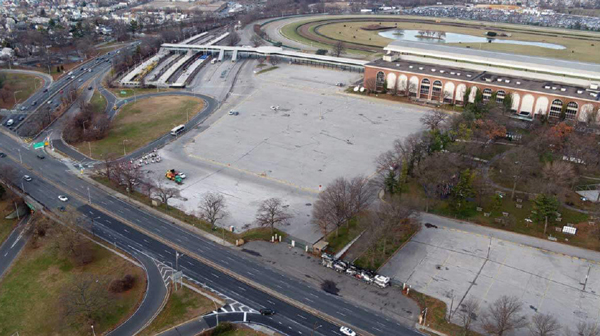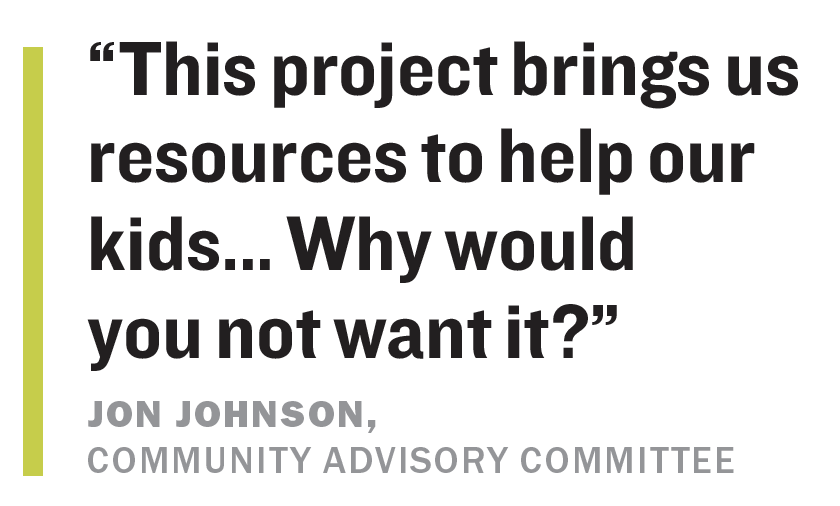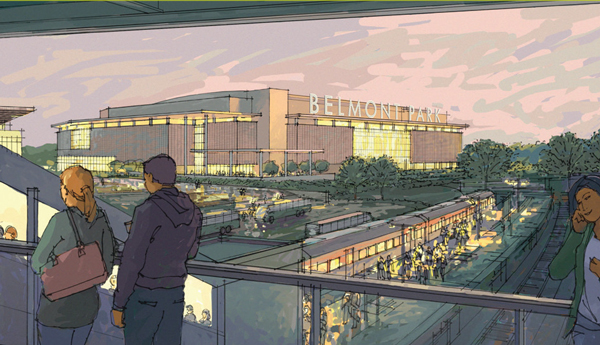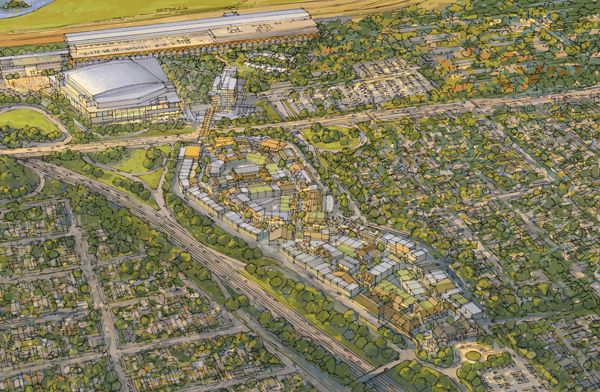The New York Islanders were eliminated from the playoffs in early May, and an even bigger prize for the National Hockey League team hangs in the balance.
A crucial environmental review to allow the Islanders and their development partners to build a brand-new home is nearing completion. The most recent iteration — a 19,000-seat arena, 250-room hotel and 435,000 square feet of retail space on state land near the famous Belmont Park horse racing track in Elmont — has raised both hopes and hackles in Nassau County and Albany.
And advocates and opponents alike are girding for battle over the $1.2 billion megaproject, which if it breaks ground as planned this summer would span 43 acres.
New York Gov. Andrew Cuomo has called it a “win, win, win,” and Empire State Development has touted the development as “a premier destination for entertainment, recreation, sports, retail and hospitality on Long Island.” Local business leaders, elected officials and other proponents, meanwhile, see the proposed arena as a way to boost jobs and economic development, and perhaps the best chance of keeping the Islanders in Nassau.
But despite the team’s popularity on Long Island, opposition from local residents and community groups has been mounting. In March, the organization Elmont Against the Megamall received $650,000 in funding from a Virginia-based nonprofit as it sought to muster resistance to building the complex, Newsday reported.
Opponents of the Belmont Park plan — which is backed by a development group led by Islanders owner and retail investor Scott Malkin, New York Mets owner Fred Wilpon, entertainment industry executive Irving Azoff and sports executive Tim Leiweke — worry about the horde of vehicles that will crowd highways and local roads, as well as the influx of people descending on their community for hockey games, shopping and other events. Some community groups are already planning to file lawsuits if the final environmental approval for the project goes through.

Belmont Park’s proposed redevelopment site
“As a community and as a coalition, we are preparing to sue in order to push back on these issues,” said Aubrey Phillips, vice president of the Parkhurst Civic Association, an organization that represents about 900 homes near Belmont Park. “We believe we have firm grounds for a lawsuit and that we have standing as taxpayers.”
Incomplete assessments
In December, the Islanders returned to the renovated Nassau Veterans Memorial Coliseum in Uniondale, having left Long Island a few years earlier to play at Brooklyn’s Barclays Center. The franchise currently splits its home games between the arenas. Earlier this year, the Islanders encouraged their fans to sign a Change.org petition supporting the Belmont Park project in the hope of moving the proposed development forward.
The team declined to comment for this story. Malkin, chairman and CEO of London-based Value Retail, which owns luxury shopping outlets in China and Europe, did not respond to a request for comment on the matter.
But after ESD’s board voted in December to adopt a 700-page environmental impact study (EIS) — one that found a revitalized Belmont Park would impact everything from air quality and water resources to socioeconomic conditions in the Elmont area — an avalanche of public comments ensued that stalled the Islanders’ plans.
The EIS suggested that the Long Island Rail Road run two additional trains on event days to help alleviate congestion concerns. The Metropolitan Transportation Authority has promised to do so, according to ESD, and the developers have agreed to supply some funding for that plan. Apart from the stress on transportation capacity, however, the EIS ultimately came to the conclusion that the megaproject would not have any adverse environmental impact.
That assessment triggered even more opposition from residents and other groups concerned about the project’s potential to affect their communities, prompting ESD to extend the review period.
 Since March, the agency has been reviewing thousands of comments from residents, local officials and others. Among them are the office of Nassau County Executive Laura Curran and even New York City Comptroller Scott Stringer, who has called for a traffic study to determine the development’s potential impact on eastern Queens.
Since March, the agency has been reviewing thousands of comments from residents, local officials and others. Among them are the office of Nassau County Executive Laura Curran and even New York City Comptroller Scott Stringer, who has called for a traffic study to determine the development’s potential impact on eastern Queens.
The Village of Floral Park alone submitted a detailed analysis raising various issues, from the need for a detailed traffic study to a concern that the completed project could throw a shadow on the Belmont Park track and scare racehorses. The final EIS is now scheduled to be released by the end of June.
At press time, the only thing that proponents and opponents alike seemed to agree on was that the LIRR station that serves Belmont Park will have to step its game up. Cuomo’s office has said the state will find a way for the LIRR to make the needed improvements — which for a full-service station could cost hundreds of millions of dollars — to take the burden off highways and local roads.
Still, who would be responsible for picking up the tab remains unclear. The LIRR itself is already under scrutiny for exorbitant overtime costs, while the MTA is facing a behemoth budget shortfall. The transit authority will propose its 2020-2024 capital plan in September, but current estimates put it at $40 billion or more.
“A train station might help, but we have to see a traffic study showing what impact it will have,” said Gerard Bambrick, Floral Park’s administrator and treasurer. “Where would they put it? When will it get done? There are lots of questions unanswered.”
The original Belmont Park plan called for construction to start this spring, with completion expected by the 2021-2022 NHL season. But the extended comment period has stretched that construction start timeline to summer at the earliest. And despite ESD’s claims that the next EIS will be completed in June to secure final approvals from the agency’s board, the state’s Franchise Oversight Board and the Public Authorities Control Board for a summer closing, a lawsuit or multiple other legal claims could further delay the development.
Bambrick, for one, said Floral Park might file such a lawsuit. “We’re prepared to do that,” he said. “We’ll wait and see what the final [EIS] looks like.”
Economic impact
The Belmont Park project, in various forms, has been under discussion for more than a decade.
Back in 2007, then-Islanders owner Charles Wang’s Lighthouse Development Group ran into opposition over its plans for a renovated 17,500-seat arena, two 31-story hotels and 250,000 square feet of convention, conference and exhibition space in Uniondale.

A rendering of the proposed arena and mixed-use project
In 2012, New York issued an RFP that anticipated selling the land to a developer but withdrew it at the end of 2016, putting the kibosh on proposals, including one by the minor league New York Cosmos soccer franchise for a $400 million mixed-use complex that would include a 25,000-seat stadium. The state reissued its RFP in July 2017, this time envisioning a ground lease arrangement, and in December of that year picked a proposal from New York Arena Partners (NYAP), a partnership formed by Wilpon’s Sterling Project Development Equities, Azoff and Leiweke’s Los Angeles-based sports and entertainment venue manager and investor the Oak View Group and the Greenwich-based Scott Malkin Group.
Malkin, grandson of late attorney and former Empire State Building owner Lawrence Wien, bought the Islanders for $485 million in late 2014 with U.S. Office Products founder Jonathan Ledecky. NYAP, which beat out a rival Belmont Park bid from the Related Companies and Major League Soccer’s New York City Football Club (the team wanted to build a 26,000-seat soccer stadium at Belmont Park), has agreed to pay $40 million to the state for a 49-year lease for the site.
The proposed development, expected to cost $1.2 billion to build by NYAP, would create 12,300 construction jobs and roughly 3,100 permanent jobs, according to ESD. When completed, the site could host 150 events each year, including 41 Islanders home games, concerts and other entertainment options. Throughout the process, NYAP has kept a low profile, as have the Islanders. None of the developers returned requests for comment about their plans for Belmont Park.
ESD, which last summer retained the law firm Hunton Andrews Kurth to advise on its portion of the project, has so far done most of the talking, mostly in more than 30 meetings with local communities. Among the development’s supporters are Curran, who last year made headlines by tapping RXR Realty to become the new master developer for the planned $1.5 billion Nassau Hub project. RXR CEO Scott Rechler did not return a request for comment about whether the Nassau Hub, a mixed-use proposal that would transform the area around the Islanders’ current arena in Uniondale, and a redeveloped Belmont Park could coexist alongside one another.
Curran, whose office declined to discuss the matter, and other Long Island politicians have qualified their support for the Belmont Park project by stating that it needs a new LIRR station to alleviate traffic problems. In March, Nassau asked ESD to take a deeper look at the potential impacts of development. Local groups such as the Elmont Chamber of Commerce are also backing the project, seeing it as a source of jobs and as an attraction for new businesses.
“It’s a great catalyst for development,” said Paul Sapienza, head of the Elmont Chamber and a longtime business owner in the community.
Sapienza sits on the 15-member Community Advisory Committee (CAC) of local elected officials and residents assembled by ESD in 2018. The agency said through a spokesperson that it has met with the group and elected officials 17 times, which led to a 10-story reduction in the height of the planned hotel, the relocation of an electrical substation away from a school and — at the developers’ expense — a planned renovation of Belmont Road Park, a public space residents claim is in serious disrepair.
“This project brings us resources to help our kids,” said Jon Johnson, another CAC member and president of the Elmont Cardinals Sports Club. “All this opportunity is being afforded to us. Why would you not want it?”
Asked about traffic congestion, Johnson said that on Long Island, “traffic will be there if the project happens or doesn’t happen.” He acknowledged that a full-service LIRR station is needed for the site but said, “it cannot be a deal-breaker when we have so much opportunity coming.”
Other obstacles
Belmont Park’s opponents believe that the increase in traffic and congestion it will cause on Long Island’s already crowded roadways is a showstopper.
They argue that the Cross Island Parkway, the main transit route to Belmont Park, is already packed during the morning and evening rush hours and cannot handle an influx of more vehicles. Elmont-area residents on both sides of the development aisle also worry that drivers, using navigation apps, will find their way to local streets, where they will park and then walk to the proposed Belmont Park complex to avoid paying parking fees.
“Queens Village could be inundated with cars parking on streets and people walking [to Belmont Park] to save $40 or $50,” said Richard Hellenbrecht, chair of the land use committee for Queens Community Board 13, which like Elmont abuts the Nassau County-Queens line.
In February, the Nassau County Village Officials Association recommended that approval for the Belmont Park project be conditioned on it getting a full-service LIRR station, with developers picking up the cost. Cuomo’s office said back in 2017 when the state chose NYAP to develop the site that the MTA was committed to “developing a plan to expand LIRR service to Belmont Park Station for events year-round.”
Now, however, the ESD will only state that the final EIS will contain a complete analysis of a full-service station, and that the outcome wouldn’t necessarily preclude the development from going forward. Even with expanded LIRR service, some skeptics claim it’s questionable whether Islander fans, most of whom live east of the proposed arena, will even take a train to games.
“The door-to-door is going to be so much faster driving there and back,” said John Kaehny, executive director of government watchdog group Reinvent Albany. “There’s no way this would take a significant number of cars off the road. There is no transit or regional planner who will say it’s a good investment to build a [train] station there.”
Traffic patterns and train service aren’t the only things on the minds of those against Belmont Park. Tammie Williams of the Belmont Park Community Coalition isn’t happy, she said, about the types of long-term jobs that could be produced.
“Basically, they are minimum wage jobs,” Williams said. “The whole purpose of urban development is to lift people off social welfare.”
Another potential issue is the energy needed to run a redeveloped Belmont Park, which won’t run on horsepower. National Grid has said it cannot guarantee that it will be able to deliver enough natural gas to the development without the expansion of an existing underwater pipeline serving Brooklyn, Queens and Long Island. That has drawn the ire of environmental groups. On May 15, New York’s Department of Environmental Conservation rejected the expansion, ruling that the construction process would disturb habitats and contaminate water with toxins. ESD said it will work with the developers on alternatives.
Lastly, there is also the question of whether Nassau needs more mall and hotel space — the county already has mixed-use projects proposed in Syosset Park and the Nassau Hub in Uniondale, where at press time Chinese e-commerce billionaire Joseph Tsai was reportedly in talks to acquire the Islanders’ part-time home, the Coliseum.
Nonetheless, the Belmont Park project has strong support in the state Legislature, which should be enough to carry it through, Kaehny said. While ESD said a cost and benefit breakdown is something it’s exploring, Kaehny’s disappointed that New York has not yet done such an analysis for funds being contributed by taxpayers.
“It’s extremely hard to answer a really simple question: how much New York taxpayers will be contributing to the project,” he said.

